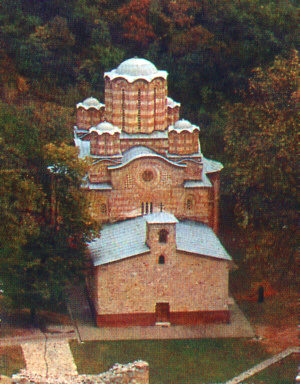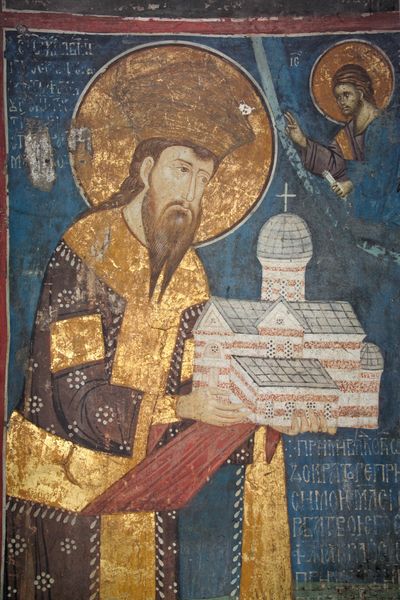|
Charter Of Ravanica
Charter of Ravanica ( sr, Раваничка повеља) was the founding charter of the Ravanica monastery, the main endowment (ktetor), and burial place of Prince Lazar of Serbia (r. 1371-1389†), issued in 1381. The Ravanica charter is not preserved in original, however, there is a well preserved copy of the Vrdnik transcript of the 17th century. The text of the charter is written in a fine dark colour, and the capital letters are in green, with a red surrounding. In the upper central part of the charter there is a depiction of Jesus Christ, and beside him, two angels. The image of Jesus is intertwined with vines of bright colours. On the charter is a silver stamp with gold platings on which the figure of Prince Lazar is on one side, and Jesus Christ on the throne on the other side. The charter is exhibited at the Museum of the Serbian Orthodox Church in Belgrade (Ed. MS 196–200). The Bologna transcript (which hasn't been published in fullĆorović-Ljubinković 1966, p. i) ... [...More Info...] [...Related Items...] OR: [Wikipedia] [Google] [Baidu] |
Ravanica
The Ravanica Monastery ( sr, / ) is a Serbian Orthodox monastery on Kučaj mountains near Senje, a village in Ćuprija municipality in Central Serbia. It was built in 1375–1377 as an endowment of prince Lazar of Serbia, who is buried there. The Ravanica church is called the birthplace of the new artistic movement "Morava school" because of architectural and artistic features. It is original blend of the Mount Athos and the cross-in-square five-domed model that became standard in the time of King Milutin. Ravanica was declared Monument of Culture of Exceptional Importance in 1979, and it is protected by Republic of Serbia. History Built between 1375 and 1377, Ravanica is the famous endowment of Prince Lazar, where he was buried after his death in the Kosovo battle. Since then, Ravanica has been a pilgrim's destination and an important center of cultural activities & assemblies for the Serbian people. The monastery was assaulted and damaged by the Ottoman Turks several ... [...More Info...] [...Related Items...] OR: [Wikipedia] [Google] [Baidu] |
Lazar Of Serbia
Lazar Hrebeljanović ( sr-cyr, Лазар Хребељановић; ca. 1329 – 15 June 1389) was a medieval Serbian ruler who created the largest and most powerful state on the territory of the disintegrated Serbian Empire. Lazar's state, referred to by historians as Moravian Serbia, comprised the basins of the Great Morava, West Morava, and South Morava rivers. Lazar ruled Moravian Serbia from 1373 until his death in 1389. He sought to resurrect the Serbian Empire and place himself at its helm, claiming to be the direct successor of the Nemanjić dynasty, which went extinct in 1371 after ruling over Serbia for two centuries. Lazar's programme had the full support of the Serbian Orthodox Church, but the Serbian nobility did not recognize him as their supreme ruler. He is often referred to as Tsar Lazar Hrebeljanović ( sr, Цар Лазар Хребељановић / ''Car Lazar Hrebeljanović''); however, he only held the title of prince ( sr, link=no, кнез / '' knez'') ... [...More Info...] [...Related Items...] OR: [Wikipedia] [Google] [Baidu] |
Charter
A charter is the grant of authority or rights, stating that the granter formally recognizes the prerogative of the recipient to exercise the rights specified. It is implicit that the granter retains superiority (or sovereignty), and that the recipient admits a limited (or inferior) status within the relationship, and it is within that sense that charters were historically granted, and it is that sense which is retained in modern usage of the term. The word entered the English language from the Old French ''charte'', via Latin ''charta'', and ultimately from Greek χάρτης (''khartes'', meaning "layer of papyrus"). It has come to be synonymous with a document that sets out a grant of rights or privileges. Other usages The term is used for a special case (or as an exception) of an institutional charter. A charter school, for example, is one that has different rules, regulations, and statutes from a state school. Charter can be used as a synonym for "hire" or "lease", as in ... [...More Info...] [...Related Items...] OR: [Wikipedia] [Google] [Baidu] |
Ktetor
''Ktetor'' ( el, κτήτωρ) or ''ktitor'' (; ka, ქტიტორი ''kt’it’ori''; ro, ctitor), meaning "founder", is a title given in the Middle Ages to the provider of funds for construction or reconstruction of an Eastern Orthodox church or monastery, for the addition of icons, frescos, and other works of art. It was used in the Byzantine sphere. A Catholic equivalent of the term is "donator". At the time of founding, the ktetor often issued typika, and was illustrated on fresco Fresco (plural ''frescos'' or ''frescoes'') is a technique of mural painting executed upon freshly laid ("wet") lime plaster. Water is used as the vehicle for the dry-powder pigment to merge with the plaster, and with the setting of the plaste ...es ("ktetor portrait"). The female form is ''ktetorissa'' ( el, κτητόρισσα) or ''ktitoritsa'' (). Sources * * History of Eastern Orthodoxy Philanthropy Byzantine culture Greek words and phrases {{Orthodoxy-stub ... [...More Info...] [...Related Items...] OR: [Wikipedia] [Google] [Baidu] |
Moravian Serbia
Moravian Serbia (), the Principality of Moravian Serbia ( sr, Кнежевина Моравска Србија, translit=Kneževina Moravska Srbija) or the Realm of Prince Lazar are the names used in historiography for the largest and most powerful Serbian principality to emerge from the ruins of the Serbian Empire (1371). Moravian Serbia was named after Morava, the main river of the region. The independent principality in the region of Morava was established in 1371, and attained its largest extent in 1379 through the military and political activities of its first ruler, prince Lazar Hrebeljanović. In 1402 it was raised to the Serbian Despotate, which would exist until 1459. History Lazar Hrebeljanović was born in around 1329 in the fortress of Prilepac, near the town of Novo Brdo in the region of Kosovo, Kingdom of Serbia. Lazar was a courtier at the court of Serbian Tsar Stefan Uroš Dušan, and at the court of Dušan's successor, Tsar Stefan Uroš V (r. 1356–1371). Ur ... [...More Info...] [...Related Items...] OR: [Wikipedia] [Google] [Baidu] |
Vrdnik
Vrdnik ( sr-Cyrl, Врдник; ) is a village located in the municipality of Irig, northern Serbia, in the Vojvodina province of Serbia. It is located at southern slopes of Fruška Gora, at the border of the national park. As of 2011 census, it has a population of 3,092 inhabitants. Name In Serbian the village is known as ''Vrdnik'' (Врдник)and in Hungarian as ''Rednek''. Features Although small, the village has several distinctive features: a thermal spa, Vrdnik-Ravanica monastery from the 16th century, former coal mine with steam power plant built in 1911, but destroyed during NATO bombing of Yugoslavia in 1999, and a ruined castle, known as Castellum Rednek or '' Vrdnička kula'' (Tower of Vrdnik). Geography Vrdnik is placed near the heart of Fruška Gora, in a valley surrounded by its slopes, at elevation of 181–260 m and coordinates . The valley is formed by three creeks named ''Dubočaš'', ''Morintov potok'' and ''Veliki potok''. Most houses are built ... [...More Info...] [...Related Items...] OR: [Wikipedia] [Google] [Baidu] |
Jesus Christ
Jesus, likely from he, יֵשׁוּעַ, translit=Yēšūaʿ, label=Hebrew/Aramaic ( AD 30 or 33), also referred to as Jesus Christ or Jesus of Nazareth (among other names and titles), was a first-century Jewish preacher and religious leader; he is the central figure of Christianity, the world's largest religion. Most Christians believe he is the incarnation of God the Son and the awaited Messiah (the Christ) prophesied in the Hebrew Bible. Virtually all modern scholars of antiquity agree that Jesus existed historically. Research into the historical Jesus has yielded some uncertainty on the historical reliability of the Gospels and on how closely the Jesus portrayed in the New Testament reflects the historical Jesus, as the only detailed records of Jesus' life are contained in the Gospels. Jesus was a Galilean Jew who was circumcised, was baptized by John the Baptist, began his own ministry and was often referred to as "rabbi". Jesus debated with fellow Jews on ho ... [...More Info...] [...Related Items...] OR: [Wikipedia] [Google] [Baidu] |
Saint Jefrem
Jefrem ( sr-cyr, Јефрем; ''Ephraem''; c. 1312 – died 1400), also known as Elder Jefrem (старац Јефрем) and Jefrem of Serbia, was the Patriarch of the Serbian Orthodox Church twice, in 1375–1379 and 1389–1392, and also a renowned poet. Biography Born into a priestly family, of Bulgarian origin, he became a monk in c. 1335 at 23 years of age. He moved to Mount Athos, and stayed at Hilandar, and later at Zograf and as a hesychastic ascetic in the mountains of Athos. He left Athos in c. 1347 for a monastery on a river island of the Maritsa near Plovdiv where he became a '' hegumen''. He then moved to Serbia, and stayed in the Patriarchal Monastery of Peć. He lived in a cave-church near Visoki Dečani The Visoki Dečani Monastery ( sr, Манастир Високи Дечани, Manastir Visoki Dečani, sq, Manastiri i Deçanit) is a medieval Serbian Orthodox Christian monastery located near Deçan, Kosovo. It was founded in the first half of .... Patria ... [...More Info...] [...Related Items...] OR: [Wikipedia] [Google] [Baidu] |
List Of Medieval Serbian Literature
Medieval Serbian literature or Old Serbian literature ( sr, Стара српска књижевност) refers to the literature written in medieval forms of Serbian language, up to the end of the 15th century, with its traditions extending into the early modern period. Background Medieval Serbia is an heir of Constantine the Great's Byzantium, the eastern part of the Roman Empire. Serbian Old Church Slavonic literature was created on Byzantine model, and at first church services and biblical texts were translated into Slavic, and soon afterward other works for Christian life values from which they attained necessary knowledge in various fields (including Latin works). Although this Christian literature educated the Slavs, it did not have an overwhelming influence on original works. Instead, a more narrow aspect, the genres, and poetics with which the cult of saints could be celebrated were used, owing to the Slavic celebration of Cyril and Methodius and their Slav discipl ... [...More Info...] [...Related Items...] OR: [Wikipedia] [Google] [Baidu] |

.jpg)



.jpg)